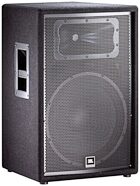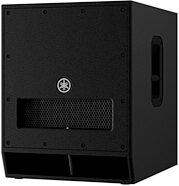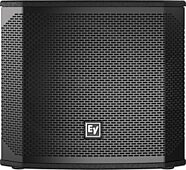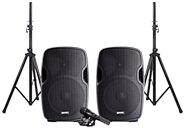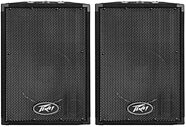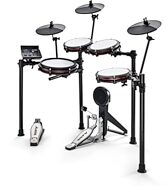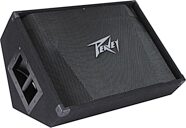Yamaha EMX860ST 8-Channel Stereo Powered Mixer
No longer available at zZounds
zZounds Gear Experts Say...
8-channel stereo powered mixer.
Overview
The EMX860ST has all the features you need to make performing simple with the least amount of hassle. The 8-channel stereo mixer has plenty of inputs, digital reverb, adjustable EQ for each channel, and a total of 600 watts of audio power.
Plenty of Inputs
With 8 channels that accept either XLR or 1/4" inputs, almost any microphone or other input can be accommodated. Inputs 7 and 8 allow connection of stereo devices like keyboards or drum machines without sacrificing the other inputs. There is also a set of tape inputs that accept RCA plugs to accept a CD player or cassette deck.
Digital Reverb
The EMX860ST has a high-quality DSP processor built inside. This device gives the user a range of effect types that are easily adjusted. This effect can be returned to the stereo mix as well as the monitor output. This way, the performer can hear the effect as well.
Built-in Graphic Equalizers
Both the main (stereo) outputs and the monitor output have 7-band graphic EQS. This allows the user to shape the sound of the main speakers as well as help control feedback in the monitors.
Plenty of Power
Inside is a total of 600 watts of audio power! The EMX860ST has 3 separate 200-watt amplifiers, 2 for the main speakers and one for use with the monitors. All 3 of these amplifiers have Yamaha's patented EEEngine Technology. This allows lighter weight and cooler operation. Built-in limiters protect the amplifier and connected speakers from damage.
Lo-Z and Hi-Z
Lo-Z input jack allows direct… read more connection of microphones with pro-style XLR connectors. Hi-Z jack enables the direct connection of high level sources (items that have internal pre-amplification) like keyboards, drum machines, CD players, etc.
Pad Switch
Pad switch decreases the input sensitivity for extra loud noises.
Level and Pan Control
The Level control manages the inputs volume. Pan control adjusts the relative position of the input in the stereo files.
Effect and Monitor Levels
Effect level control adjusts the amount of signal sent to the effects section of the mixer. Monitor level controls the volume sent to the monitor section.
Channel EQ Section
Channel EQ section includes controls that adjust the equalization of each of the separate inputs. Enabling you to bring out sounds from each of the inputs that might not be easily heard in the overall mix.
Digital Effect and Effect Out
Digital effect provides a high-quality DSP effect that's applied to the main output and is available for the monitor output as well. Effect out adjusts the amount of signal sent to the internal (or external) effect device.
Monitor Graphic EQ
Monitor Graphic EQ tailors the overall sound to the monitor output and helps to reduce the chance for feedback.
Phantom Power
The Phantom Power switch activates phantom power in the Lo-Z inputs. Phantom power is used for condenser microphones which have small internal amplifiers that require power in order to produce sound.
Monitor Master and Monitor Effect
Monitor master level adjusts the output of the monitor section. An LED meter indicates this level. Monitor effect return controls the amount of effect that is sent to the monitors. This useful control allows the performer(s) to enjoy the effect as well as the audience.
Main Graphic EQ
Main graphic EQ allows you to tailor the sound of both left and right main (audience) outputs.
Limiter LEDs
Limiter LEDs indicate when the internal amplifiers are being overworked. This warning signal helps avoid damaging the amplifiers of your speakers.
Amplifier Routing
The Amplifier routing switch allows you to bridge both the left and right power amplifiers together to provide 400-watts to a single speaker.
Main Master
Main master level adjusts the output to the main speakers. An LED meter indicates the level.
Tape In and Aux In
Tape In control adjusts the level of the signal connected to the Tape In jacks that's sent out the main stereo outputs. Aux In controls the level of the signal coming into the Aux In jacks.
Effect Return
Effect Return adjusts the amount of effect that is sent to the main outputs.
Monitor Output Jack
Monitor output jack connects additional amplifier(s) and monitor speakers when needed.
Main Outputs L and R
Main outputs (L and R) permit you to hook the EMX860ST into an existing sound system. They also let you use the EMX860ST as a sub-mixer for a larger system so you'll never outgrow the EXM860ST.
REC Out Jacks
REC out jacks connect the EMS860ST to a cassette deck or other recorder. The output level of these jacks is optimized for recording applications.
Tape in and Aux In Jacks
Tape in jacks accept a tape player or CD player output and routes it directly to the main stereo outputs. This feature allows you to keep all 8 normal inputs available for other sources. Aux In jacks allow the output of another mixer into the EMX860ST. (i.e. a keyboard player or drummer with their own sub-mixer) again leaving the other 8 inputs open for other inputs.
Foot SW Jack
Foot SW jack allows the use of a footswitch to mute the effect (this is helpful when you need to quickly turn the reverb off or on).
Effect Out Jack
Effect Out jack sends signal to an external effects processor.
Line Inputs
Line Inputs (L and R) let you get a stereo input (like a keyboard) into just one input channel. Both channels 7 and 8.
Monitor Output Jacks
Monitor output jacks to connect the monitors (stage speakers).
Bridge Output Jacks
Left and Right Bridge output jack allows hookup of BOTH main amplifiers (400W) to one speaker.
Fan
A small, quiet fan cools the 600-watts of total power. read less
Plenty of Inputs
With 8 channels that accept either XLR or 1/4" inputs, almost any microphone or other input can be accommodated. Inputs 7 and 8 allow connection of stereo devices like keyboards or drum machines without sacrificing the other inputs. There is also a set of tape inputs that accept RCA plugs to accept a CD player or cassette deck.
Digital Reverb
The EMX860ST has a high-quality DSP processor built inside. This device gives the user a range of effect types that are easily adjusted. This effect can be returned to the stereo mix as well as the monitor output. This way, the performer can hear the effect as well.
Built-in Graphic Equalizers
Both the main (stereo) outputs and the monitor output have 7-band graphic EQS. This allows the user to shape the sound of the main speakers as well as help control feedback in the monitors.
Plenty of Power
Inside is a total of 600 watts of audio power! The EMX860ST has 3 separate 200-watt amplifiers, 2 for the main speakers and one for use with the monitors. All 3 of these amplifiers have Yamaha's patented EEEngine Technology. This allows lighter weight and cooler operation. Built-in limiters protect the amplifier and connected speakers from damage.
Lo-Z and Hi-Z
Lo-Z input jack allows direct… read more connection of microphones with pro-style XLR connectors. Hi-Z jack enables the direct connection of high level sources (items that have internal pre-amplification) like keyboards, drum machines, CD players, etc.
Pad Switch
Pad switch decreases the input sensitivity for extra loud noises.
Level and Pan Control
The Level control manages the inputs volume. Pan control adjusts the relative position of the input in the stereo files.
Effect and Monitor Levels
Effect level control adjusts the amount of signal sent to the effects section of the mixer. Monitor level controls the volume sent to the monitor section.
Channel EQ Section
Channel EQ section includes controls that adjust the equalization of each of the separate inputs. Enabling you to bring out sounds from each of the inputs that might not be easily heard in the overall mix.
Digital Effect and Effect Out
Digital effect provides a high-quality DSP effect that's applied to the main output and is available for the monitor output as well. Effect out adjusts the amount of signal sent to the internal (or external) effect device.
Monitor Graphic EQ
Monitor Graphic EQ tailors the overall sound to the monitor output and helps to reduce the chance for feedback.
Phantom Power
The Phantom Power switch activates phantom power in the Lo-Z inputs. Phantom power is used for condenser microphones which have small internal amplifiers that require power in order to produce sound.
Monitor Master and Monitor Effect
Monitor master level adjusts the output of the monitor section. An LED meter indicates this level. Monitor effect return controls the amount of effect that is sent to the monitors. This useful control allows the performer(s) to enjoy the effect as well as the audience.
Main Graphic EQ
Main graphic EQ allows you to tailor the sound of both left and right main (audience) outputs.
Limiter LEDs
Limiter LEDs indicate when the internal amplifiers are being overworked. This warning signal helps avoid damaging the amplifiers of your speakers.
Amplifier Routing
The Amplifier routing switch allows you to bridge both the left and right power amplifiers together to provide 400-watts to a single speaker.
Main Master
Main master level adjusts the output to the main speakers. An LED meter indicates the level.
Tape In and Aux In
Tape In control adjusts the level of the signal connected to the Tape In jacks that's sent out the main stereo outputs. Aux In controls the level of the signal coming into the Aux In jacks.
Effect Return
Effect Return adjusts the amount of effect that is sent to the main outputs.
Monitor Output Jack
Monitor output jack connects additional amplifier(s) and monitor speakers when needed.
Main Outputs L and R
Main outputs (L and R) permit you to hook the EMX860ST into an existing sound system. They also let you use the EMX860ST as a sub-mixer for a larger system so you'll never outgrow the EXM860ST.
REC Out Jacks
REC out jacks connect the EMS860ST to a cassette deck or other recorder. The output level of these jacks is optimized for recording applications.
Tape in and Aux In Jacks
Tape in jacks accept a tape player or CD player output and routes it directly to the main stereo outputs. This feature allows you to keep all 8 normal inputs available for other sources. Aux In jacks allow the output of another mixer into the EMX860ST. (i.e. a keyboard player or drummer with their own sub-mixer) again leaving the other 8 inputs open for other inputs.
Foot SW Jack
Foot SW jack allows the use of a footswitch to mute the effect (this is helpful when you need to quickly turn the reverb off or on).
Effect Out Jack
Effect Out jack sends signal to an external effects processor.
Line Inputs
Line Inputs (L and R) let you get a stereo input (like a keyboard) into just one input channel. Both channels 7 and 8.
Monitor Output Jacks
Monitor output jacks to connect the monitors (stage speakers).
Bridge Output Jacks
Left and Right Bridge output jack allows hookup of BOTH main amplifiers (400W) to one speaker.
Fan
A small, quiet fan cools the 600-watts of total power. read less
Specs
Maximum Output Power
Main Stereo: 200W + 200W/4 ohms @ 0.5% THD at 1 kHz; Main Bridge 400W/8 ohms@ 0.5% THD at 1kHz
Monitor: 200W/4 ohms @ 0.5% THD at 1kHz
Frequency Response
20Hz~20kHz +1dB, -3dB @ 1 watt output into 8 ohms. (POWER AMP OUT);
20Hz~20kHz +1dB, -3dB @ +4dB output into 10k ohms. (MAIN outs, MONITOR out, EFFECT out)
Total Harmonic Distortion
Less than 0.5% @ 20Hz~20kHz, 100W output into 4 ohms. (POWER AMP OUT);
Less than 0.3% @ 20Hz~20kHz, +14dB output into 10k ohms. (MAIN outs, MONITOR out, EFFECT out)
Hum and Noise
(Average, Rs=150 ohms) (with 20Hz~20kHz BPF) -125dB Equivalent Input Noise; -68dB Residual Output Noise (POWER AMP OUTPUTS); -95 dB Residual Output Noise (MAIN OUT, MONITOR OUT, EFFECT OUT)
Crosstalk at 1kHz
-65dB adjacent input; -65dB input to output
Input Channel Equalization + or - 15dB Maximum
HIGH 10kHz shelving; MID 2.5 kHz peaking; LOW 100 Hz shelving (Turn over/Rolloff frequency of shelving: 3dMeters HIGH 10kHz shelving; MID 2.5 kHz peaking; LOW 100 Hz shelving (Turn over/Rolloff frequency of shelving: 3dB below maximum variable level.)
Meters
3 x 5 LED meter (Main Out L and R, Monitor Out)
Graphic Equalizer
7 bands (125, 250, 500, 1k, 2k, 4k, 8kHz) +/- 12dB Maximum (Main out stereo, Monitor out)
Internal Digital Effect
3 types (Vocal, L Hall, S Hall)
Phantom Power
+48V is supplied to electrically balanced inputs for powering condenser microphones or direct boxes via current limiting/isolation resistors.
Limiter Comp
THD> or = 0.5% (Mains, Monitor)
Foot switch
Digital Effect Mute: On/Off
Power Requirements
120V AC 60Hz 300W
Dimensions (W x H x D)
497 x 324 x 275mm (19-5/8 x 12-3/4 x 10-7/8 in.)
Weight
37.4 lbs. (17 kg)
Main Stereo: 200W + 200W/4 ohms @ 0.5% THD at 1 kHz; Main Bridge 400W/8 ohms@ 0.5% THD at 1kHz
Monitor: 200W/4 ohms @ 0.5% THD at 1kHz
Frequency Response
20Hz~20kHz +1dB, -3dB @ 1 watt output into 8 ohms. (POWER AMP OUT);
20Hz~20kHz +1dB, -3dB @ +4dB output into 10k ohms. (MAIN outs, MONITOR out, EFFECT out)
Total Harmonic Distortion
Less than 0.5% @ 20Hz~20kHz, 100W output into 4 ohms. (POWER AMP OUT);
Less than 0.3% @ 20Hz~20kHz, +14dB output into 10k ohms. (MAIN outs, MONITOR out, EFFECT out)
Hum and Noise
(Average, Rs=150 ohms) (with 20Hz~20kHz BPF) -125dB Equivalent Input Noise; -68dB Residual Output Noise (POWER AMP OUTPUTS); -95 dB Residual Output Noise (MAIN OUT, MONITOR OUT, EFFECT OUT)
Crosstalk at 1kHz
-65dB adjacent input; -65dB input to output
Input Channel Equalization + or - 15dB Maximum
HIGH 10kHz shelving; MID 2.5 kHz peaking; LOW 100 Hz shelving (Turn over/Rolloff frequency of shelving: 3dMeters HIGH 10kHz shelving; MID 2.5 kHz peaking; LOW 100 Hz shelving (Turn over/Rolloff frequency of shelving: 3dB below maximum variable level.)
Meters
3 x 5 LED meter (Main Out L and R, Monitor Out)
Graphic Equalizer
7 bands (125, 250, 500, 1k, 2k, 4k, 8kHz) +/- 12dB Maximum (Main out stereo, Monitor out)
Internal Digital Effect
3 types (Vocal, L Hall, S Hall)
Phantom Power
+48V is supplied to electrically balanced inputs for powering condenser microphones or direct boxes via current limiting/isolation resistors.
Limiter Comp
THD> or = 0.5% (Mains, Monitor)
Foot switch
Digital Effect Mute: On/Off
Power Requirements
120V AC 60Hz 300W
Dimensions (W x H x D)
497 x 324 x 275mm (19-5/8 x 12-3/4 x 10-7/8 in.)
Weight
37.4 lbs. (17 kg)
Documents and Manuals
For support or warranty questions, please contact the manufacturer:
Phone: 714-522-9011
Web: https://usa.yamaha.com/support
Phone: 714-522-9011
Web: https://usa.yamaha.com/support
No longer available at zZounds
In most cases, a product is unavailable because it has been discontinued by the manufacturer
This is a carousel with product cards. Use the previous and next buttons to navigate.



